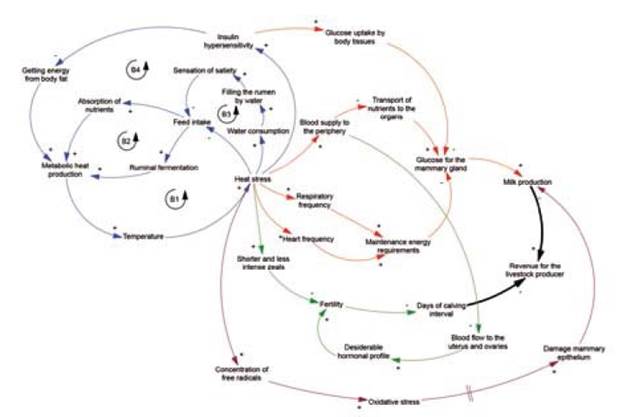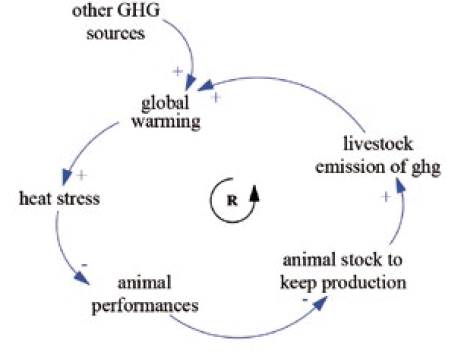Introduction
Livestock activities are very important from social, economic and geopolitical point of views. Livestock contributes with 40% of GDP of world agriculture, which involves 1300 million people and provides subsidence to one billion people, among those with lowest income around the world (Gaughan, Lacetera, Valtorta, Khalifa, Hahn & Mader, 2009). Climate influences the agriculture system under four major aspects as follows: i) availability of feeds and prices, ii) production and quality of pastures and forages, iii) production, reproduction, growth and health of livestock animals iv) geographical distribution of diseases (Rotter & Van de Geijn, 1999).
Influence of climate on animal behavior and productivity has been demonstrated for many years. In fact, thermal environment is the most important ecological factor to determine growth, development and productivity of domestic animals (Collier & Gebremedhin, 2014). Animals like cattle (endotherms), have the ability to control their homoeothermic regulation within a range. In environments where temperature variations could be extended, they could face adverse climate scenarios (Molina, Silva, Perilla & Sánchez, 2016).
Combination of meteorological variables, can lead to unfavorable situations for animals, such as heat stress, which causes negative animal responses involving physiological activities related to respiration, intake, digestion, blood circulation, etc. It is known that these aspects provides more accurate and reliable estimates of large impact both on reproduction and production in terms of yield and quality (Dunshea, Leury, Fahri, DiGiacomo, Hung, Chauhan, Clarke, Collier, Little, Baumgard & Gaughan, 2013; Bertocchi, Vitali, Lacetera, Nardone, Varisco & Bernabucci, 2014).
Productive and reproductive efficiency of dairy cattle had achieved a great decreasing under high temperatures and losses due to heat stress. US dairy cattle losses have been quantified about 900 million dollars per year, due to changes in greenhouse gases composition in atmosphere, which impacted the historical behavior of global climate, the number of events outside and minimum and maximum historical ranges of temperatures (Gerber, Steinfeld, Henderson, Mottet, Opio, Dijkman, Falcucci & Tempio, 2013).
It is known that forecasted trend is climate change will increase the number of annual days when the animals are under heat stress conditions (Avendaño, 2012). Some literature citations on the influence of physiological mechanism that regulates the animal strain to thermal stress (Barragan, Mahecha & Cajas, 2015; Barrera, Angeli, Machado, Cardoso & Gonzalez, 2015; Belhadj, Najar, Ghram & Abdrrabba, 2015; Collier,Zimbelman, Rhoads, Rhoads & Baumgard, 2011; Dunshea et al., 2013; Molina, Silva, Perilla & Sánchez, 2016; Pejman & Shahryar, 2012).
Farmers will also be able to better manage the health and welfare of their herds and most likely gain additional years of productivity from their cows. Managerial choices of a producing farm should be oriented to implement practices addressed to minimize negative animal reactions and to keep constant the physiological functions, which support livestock production. Regardless of breed, age, size, feeding and the health of dairy cows; heat stress will affect two main productivity criteria: milk production and fertility rate. Heat stress will also undermine the physical state of dairy cows.
Bearing this in mind, the present work is intended to present a systemically understanding of the interactions among major variables related with heat stress in dairy cows.
Material and methods
In order to explain the dynamics of heat stress problem and highlight the feedback structure, a causal loop diagram for variables of interactions associated with heat stress in dairy cattle, was developed.
Convention for drawing a causal loop diagram is simple, consisting of set of variables connected by arrows denoting the causal influence. Arrows always start from independent variable (A) to dependent variable (B). Each arrow is assigned to a polarity (+/-) indicating that variable B modifies as a function of variable A (all other variables assumed constant). If the sign is +, two variables move in same direction; if the sign is -, two variables move in opposite directions. In some cases, where variables start from the causal arrow can become site arrival of a causal link, giving rise to a feedback loop. These loops are also assigned polarity. If the number of negative causal relationships is even, the loop is reinforcing (R / +), otherwise it will balance (B / -). Balance loops seek to regulate the system, reinforcing loops promote the growth or decline of the same (Sterman, 2000). Causal diagram (CLD) was built using Vensim® PLE plus software version 6.3. Variables related to physiological, productive, reproductive, health and environmental components to explain the effect of meteorological variables (temperature, solar radiation, relative humidity, wind speed) on lactating dairy cows, were modeled.
Results
Causal loop diagram
A causal loop diagram was drawn to represent the structure of the proposed conceptual model. In this type of diagram are shown variables associated with heat stress problem in cattle, their interactions and feedback loops formed.
In Figure 1, four balancing loops aimed to achieve thermal homeostasis are shown.
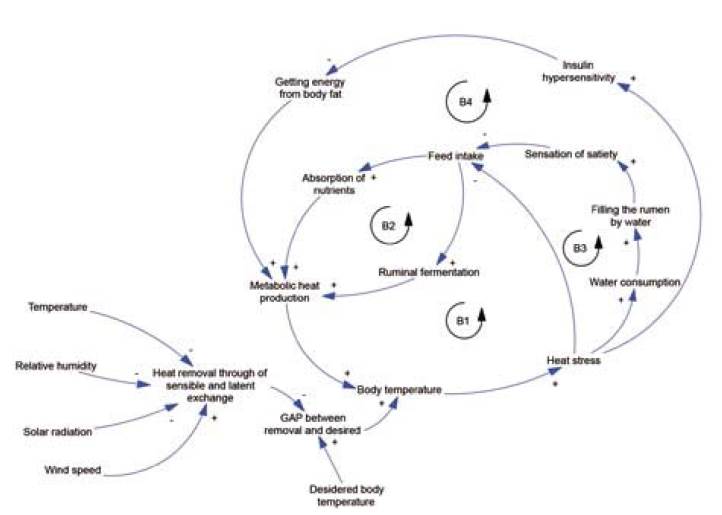
Figure 1 Conceptual diagram showing causal relationships of the variables associated with study problem and feedback loops.
The loops B1 and B2 showed that when animal is under heat stress, a major strategy implemented to have allowed a decreasing in metabolic heat production is lowering feed intake.
In Figure 2, some other metabolic effects of heat stress in dairy cows, were shown.
From a modeling point of view, causal loop drawn in Figure 3, can be truly presented and each single connection could be documented in literature.
Each connection represented in Figure 4 should be documented in literature but whole loop is very unlikely to apply advantage on the system.
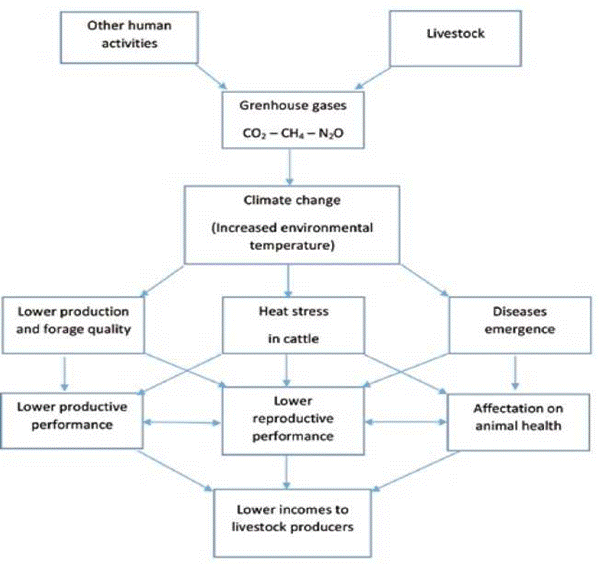
Figure 4 Causal relationship between livestock, climate change and profitability of livestock systems.
In order to avoid misunderstandings, a linear consequence of causal relationships might describe a linkage among livestock, global warming, heat stress and animal strain (Figure 5).
An additional feedback loop diagram might explain that heat stress have allowed a management in a separate loop that act on the short term and also that a possible effect involving livestock emissions, which have an impact on climate change delayed through a long interval (Figure 5).
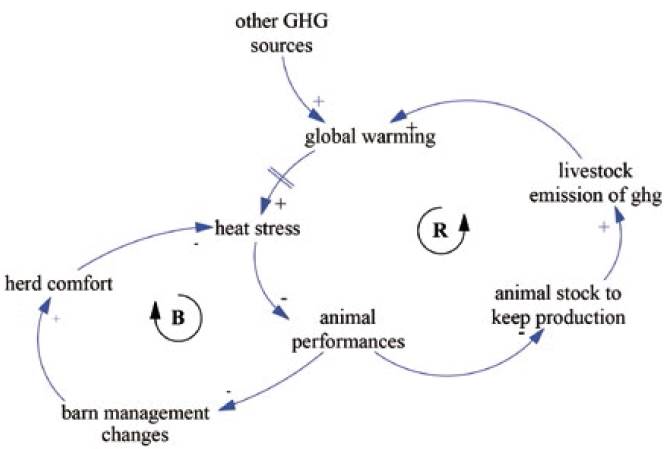
Figure 5 Conceptual diagram for global warming- anthropogenic activities and its influence on heat stress in dairy cows.
Global warming caused by anthropogenic activities is more related to heat stress in dairy cows. It causes an inefficiency of the balancing loop and a dominance of the reinforcing loop, and an increasing in global warming due to the exogenous variable in the long run, will lead to inefficient practices of heat stress control at farm level.
Discussion
The proposed setup is a conceptual approach for developing a model linked to experimental measurements, which helps to validate the reliability and accuracy of the proposed model, and it becomes a multifunctional strategy for farmers to take preventive measures in favor to ameliorate heat stress in dairy cows.
It is assumed that animal should maintain a quite stable temperature in a thermo-neutral zone to keep their metabolic activities under normal conditions. Therefore, to had achieved this homeostasis, the amount of heat gained with metabolic processes and solar radiation, must be equal to the amount of heat lost throughout the most efficient energy exchange routes as follows: 1) sensible heat: conduction, convection and radiation, and 2) latent heat: panting and sweating (Collier & Gebremedhin, 2014). The environmental temperature, solar radiation, relative humidity and wind speed influence positively or negatively on these routes (Molina, Silva, Perilla & Sánchez, 2016).
When dairy cows become susceptible to heat stress, the persistence of high temperature and humidity within the dairy barn become an important issue. Investigations have demonstrated that, along with adversely affecting the welfare of the cow, heat stress can significantly decrease milk production and fertility rate (Pejman & Shahryar, 2012).
In the 1950~s Hans Selye quoted that "...is not stress that kills us, it is our reaction to it.", which indicates that the relationship between stress and live organisms is affected by a feedback perception. (Barragan, Mahecha & Cajas, 2015; Oliveira, Costa, Souza, Fernandes, Maia & Costa, 2014) . Lowering animal feed intake reduce ruminal fermentation processes and exergonic digestion and absorption of nutrients. With high availability of drinking water, satiety by copious liquid intake causes increases of rumen fill which slightly inhibit feed intake, as reported in the loop B3 (Pejman & Shahryar, 2012). Furthermore, heat stress induces hypersensitivity to insulin (Belhadj, Najar, Ghram, & Abdrrabba, 2015) , decreasing body fat mobilization for gluconeogenesis and decreasing the metabolic heat production (B4).
From loop diagram represented in Figure 2, can be argue that involves three short routes and a long route. Short routes are shown with red arrows and are described as follows: i) increasing respiratory and heart rates as defense mechanisms against an increasing in temperature; which increases maintenance energy requirements and had achieved a decreasing in glucose content available for mammary gland (Collier et al., 2011), ii) increasing blood supplying to periphery tissues, which causes fewer transport of nutrients to organs, especially less glucose to mammary gland (Barrera et al., 2015); iii) hypersensitivity to insulin (Belhadj, Najar, Ghram & Abdrrabba, 2015), which causes greater glucose uptake by adipose tissues (insulin dependent), and had achieved a decreasing in the amount of available glucose for mammary gland (insulin independent).
As many studies have shown, during hot, humid weather, a dairy cow risks suffering from heat stress, a physiological response that reduces the overall dairy cows welfare and productive capacity. Investigations of heat stress, such as Barragan, Mahecha & Cajas (2015); Barrera et al. (2015); and Collier et al. (2011), have found that stress induced by excessive heat begins to set in when the ambient temperature rises above 23°C or 31°C in conjunction with 100% and 0% relative humidity, respectively.
The long route, marked with brown arrows, show that under heat stress, there are increases of free radical concentrations leading to oxidative stress, causing delayed damages to the mammary epithelium (Anzures, Macias, Álvarez, Correa, Diaz, Hernández & Avendaño, 2015), which results in a near future in a decreasing milk production. Furthermore, heat stress had achieved a marked effect on animal reproduction with green arrows. First, blood supplying to periphery have allowed a decreasing in blood flow through uterus and ovaries reducing hormone levels and the estrus evidence. Conversely, causes low fertility and longer calving intervals (Geers, Vermeulen, Snoeks & Permentier, 2014; Lima da Costa, Feitosa, Montezuma, Teixeira & Alencar, 2015). All those heat stress loops end with income losses for producers.
The intensity of heat stress and the length of time, in dairy cows will determine the severity of physiology modification, such frequency and variability will have repercussions over the short and long term. An initial dairy cows reactions depend on its own cooling mechanisms; dairy cows will sweat and send more blood flowing to its skin, carrying with it body heat to be released via perspiration (Collier et al., 2011).
A heat-stressed cow will also pant, thereby expelling heat through water vapor with each breath, and in order to increase the amount of skin surface to the air, a cow will stand up for longer periods when is suffering heat stress. All of these actions require some metabolic energy and the supply to dairy cow will reduce the amount of metabolic energy, which is normally spent on milk production (Key, Sneeringer & Marquardt, 2014; Collier & Gebremedhin, 2014; Anzures et al., 2015).
Conclusion
The use of conceptual models as proposed in this study, have allowed a better understanding of the heat stress problem in dairy cows. Within a farm focus, practices of heat stress reduction and improvements of animal strain, helps to ameliorate heat stress and keep animal performances in short term. Given these concerns and even if livestock farming contributes to global warming, feedback of global warming on heat stress in dairy cows is not manageable within a simple approach on animal emissions; in addition, exogenous components might impair an effectiveness of farm strategies adopted to maintain livestock performances under heat stress conditions.













